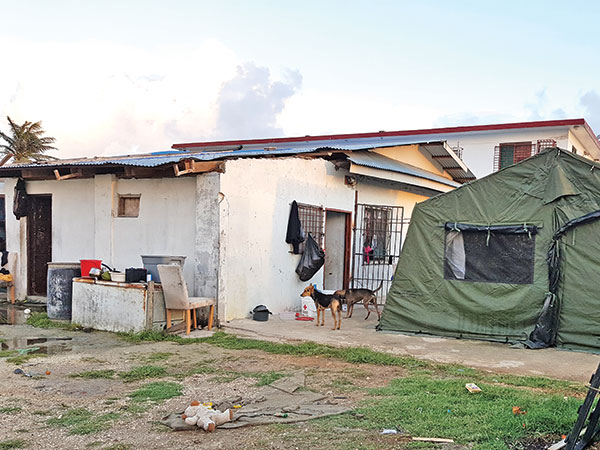Families still awaiting housing aid
Second part of a series
Editor’s Note: The following is part of a continuing series that Saipan Tribune correspondent Reica Ramirez is examining to see how people are coping six months after Super Typhoon Yutu devastated Saipan and Tinian.
Soon after Super Typhoon Yutu levelled Saipan and Tinian in October 2018, many families were given tents where they could take shelter from the sun and rain. Those tents were supposed to be temporary. Yet six months later today, many of these families still live in those tents.
Of the many factors that are in play why so many families are still stuck in temporary homes, it all comes down to money—or the lack of it. Many cite a delay in government assistance, higher rent in nearby homes, or a lack of funds to begin the repairs themselves.
A 41-year old mother of seven, who asked that she be identified only as Sanry, struggles living in a broken house with just a tent to support them. “It’s very hard, especially for my kids. It floods inside [the tent and broken house] when it rains.”
Instead of moving to a new place, Sanry decided to stay in her current place because her rent is cheaper compared to other nearby houses.
Sanry’s family has already applied for help from the Federal Emergency Management Agency, but she said they were not provided housing assistance.
“I wish everything can go back to normal. My kids still go to school and they come back to a place with no power, a flooded tent, and a broken house,” she said.
Many are still waiting for FEMA assistance. One, Enrico San Jose, is waiting for FEMA to help him fix his house. “FEMA workers came to my house to measure the property. It’s not in my mind to leave [my house] because I was told that we’re in the waitlist. I have hope it will be fixed as soon as possible,” he said.
Since his house still has no power, San Jose’s family depends on a generator to provide electricity throughout the property.
In another case, a widowed mother who lives alone could not leave her house because she has no immediate families on Saipan.
“It’s easier for me to be in my house rather than stay in another place because I have a lot of stuff that can’t be moved and dogs to take care of,” she said.
FEMA did offer to build her house for her, but she was required to move out, along with all her belongings. She declined this offer because she would not be provided any reimbursement for any rental fees or transportation services. Instead, she accepted the financial aid offer that would let her repair her house on her own. However, six months later, she is still waiting for the FEMA financial assistance that would allow her to get the repairs started.
She is grateful that she still has a job that can support her. “I’m still waiting, but I’m just trying to move on because that’s all we can do,” she added.
A 17-year old boy with nine siblings still live in a small tent to survive. During the typhoon, the roof in his home was blown away, so his family had to run to a neighbor’s house for shelter. They lived in the temporary Marianas High School shelter for a couple of weeks and were provided a tent under the federal government’s Temporary Emergency Tent and Roofing Installation Support program once they left the shelter.
When asked why his family still stays in their broken home, he said, “We’ve been living here since I was born. It’s the only place we can really call home. It’s not much, but it’s what we can afford.”
His family was one of the few lucky ones that were given housing assistance by FEMA and they have already started work on repairing their house. “We’re one of the lucky ones and I’m extremely grateful.”




























